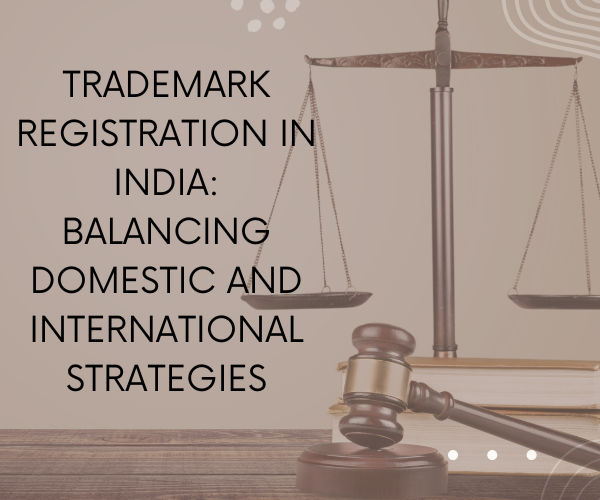
Trademark Registration in India: Balancing Domestic and International Strategies
In the competitive world of business, trademarks play a pivotal role in distinguishing one company’s goods or services from another. These legal identifiers are commonly known as ‘trademarks,’ serving as a critical tool for establishing a unique identity, reputation, and goodwill for a business entity. The legal protection of these trademarks is contingent upon their registration with the relevant government authority, such as the Trade Marks Registry in India.
It is important to note that trademark protection is primarily territorial in nature, meaning that a trademark registered in one country, such as India, is only safeguarded within its borders. In the era of globalization, companies with international operations must secure trademark registrations in multiple countries. This raises the question of how to register a trademark in various jurisdictions, and in this article, we focus on the methods available for registering trademarks in India.
Registering Foreign Trademarks in India
The registration of trademarks in India is governed by the Trade Marks Act of 1999 and the Trade Mark Rules of 2017. However, this framework primarily addresses domestic filings. To delve into international filings, we must explore the Madrid System. Consequently, two distinct paths are available to foreign entities seeking to register their trademarks in India: filing directly with the Indian Trade Marks Registry and filing through the Madrid System.
Registering a trademark domestically in India necessitates navigating the registration process outlined in domestic laws, requiring the engagement of trademark attorneys experienced in Indian law.
Public Search
The initial step involves conducting a public search on the government’s official website to ensure that there are no identical or similar trademarks already registered. Subsequently, an application, accompanied by the requisite fees, is filed. The Trade Marks Registry examines the application and issues an Examination Report. If the trademark is approved during this stage, it is advertised in the Trade Marks Journal, serving the purpose of notifying the public about new applications and providing an opportunity for opposition in the case of identical or similar trademarks. If an opposition is filed within the stipulated time, opposition proceedings commence. Otherwise, the trademark is registered.
Filing under the Madrid System
The Madrid System, established under the Madrid Agreement and the Madrid Protocol, is facilitated by the World Intellectual Property Organization (WIPO) and is designed to streamline trademark registration across multiple jurisdictions. This system allows applicants to apply for trademark registration in multiple countries with a single application. The procedure for filing under the Madrid System is detailed below.
Filing with the Country of Origin
The “country of origin” refers to the location of the applicant’s principal place of business. To initiate the process under the Madrid System, the concerned trademark must first be registered in the country of origin. Subsequently, the International Application, in the form of MM2, must be submitted, along with the required documents and fees in compliance with the domestic laws of the country of origin. The applicant must specify all the countries in which they seek registration, known as designated contracting parties. In this case, India must be selected as one of the designated contracting parties, resulting in the allocation of an international application originating number according to the country of origin.
The office of origin then forwards the application to the International Bureau of WIPO, which scrutinizes International Applications received from the offices of origin. Any irregularities discovered are communicated to the concerned office of origin and the applicant’s authorized representative, who must rectify these irregularities within the prescribed period. Upon completion, the trademark is registered in the International Register, published in the WIPO Gazette of International Marks, and a Certificate of Registration is issued. The International Bureau subsequently notifies the designated contracting party, such as India in this case, about the International Application.
Examination by the Trade Marks Office – India
Upon receiving the International Application from WIPO, the Indian Trade Marks Registry examines the application in accordance with the domestic laws of 2017. It evaluates the scope of protection to be granted to the trademark. It’s essential to note that the Indian Trade Mark Registry is not obliged to automatically grant protection to a trademark in India solely because it has been registered in the International Register.
Advertisement and Oppositions
After successfully navigating objections raised by the Trade Mark office, if applicable, and receiving acceptance, the trademark enters a crucial phase of the registration process – a four-month period of public advertisement. It’s during this window that any third party holds the opportunity to challenge the mark by filing oppositions. The issuance of a Notice of Opposition serves as the formal initiation of opposition proceedings. These proceedings provide a structured and transparent avenue for addressing and resolving potential conflicts and disputes related to trademarks.
Analysis and Conclusion
With a fundamental understanding of both procedures, it is crucial to consider which approach is more advantageous. The duration of protection granted under both methods is identical, lasting for 10 years and renewable without limitation. The term of renewal is also 10 years. This equality in protection duration necessitates a cost-effectiveness analysis.
A domestic application is typically cheaper compared to an application under the Madrid System. However, the process becomes more laborious when seeking registration in numerous jurisdictions, as it requires the preparation of multiple domestic applications. In contrast, the Madrid System allows for registration in multiple jurisdictions without the need for multiple individual applications. Applicants need only specify the countries where they seek registration. Thus, the choice of procedure should be made on a case-by-case basis.
In conclusion, the decision between domestic and international trademark registration in India depends on the specific needs and objectives of the business. Both methods offer comprehensive protection, and the choice ultimately hinges on cost considerations and the extent of international reach a company aims to achieve.